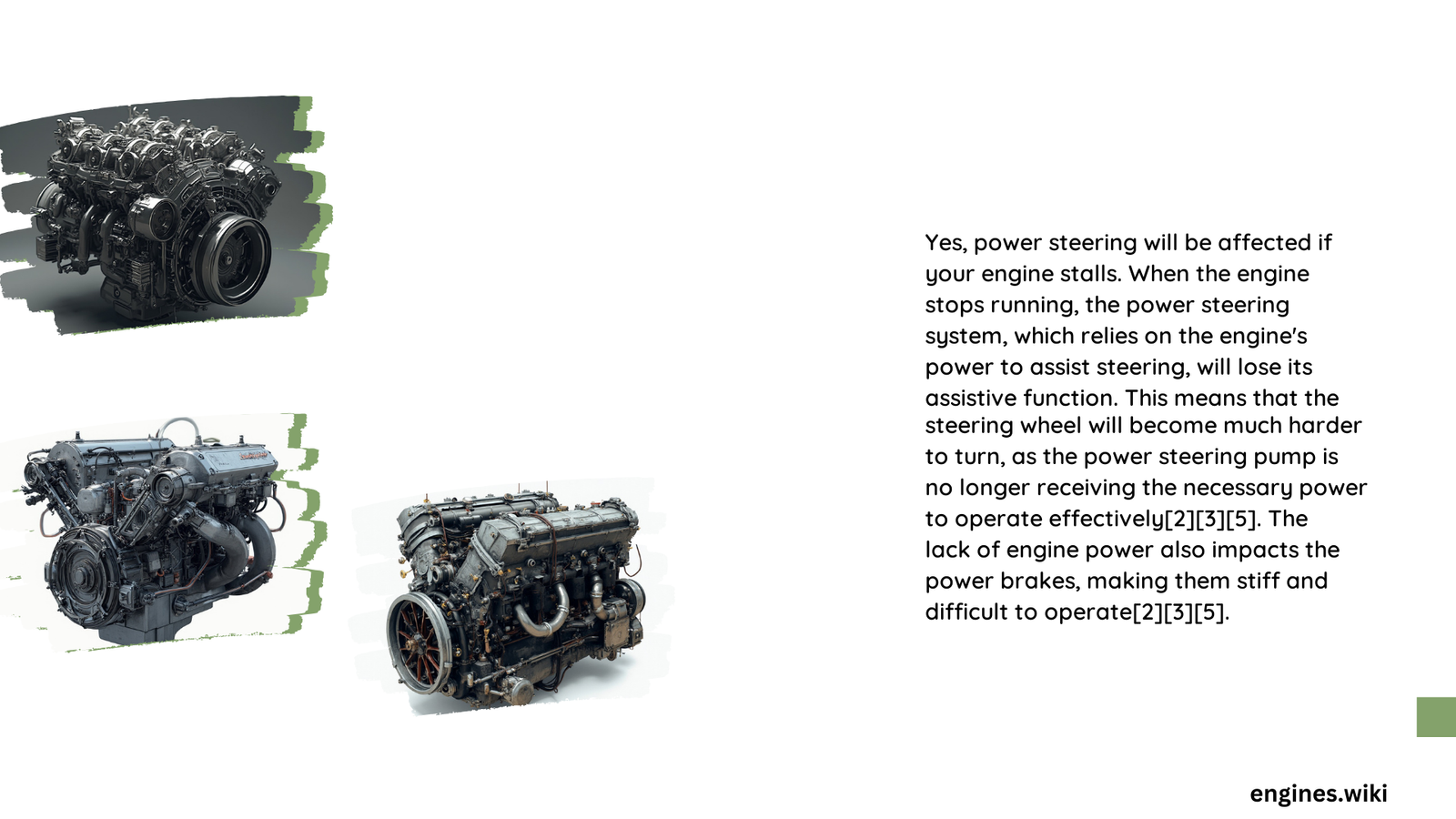When an engine stalls, power steering is significantly impacted. For hydraulic systems, the loss of engine power means immediate loss of steering assist. Electric power steering may continue functioning briefly but will eventually fail as the electrical system drains. This article explores the effects of engine stalling on power steering, safety implications, and what drivers should do in such situations.
What Happens to Power Steering When the Engine Stalls?
When your engine stalls, the power steering system is immediately affected, regardless of whether it’s hydraulic or electric. Here’s a breakdown of what happens:
Hydraulic Power Steering Systems
- Immediate loss of power assist
- Steering becomes significantly harder
- Requires much more physical effort to turn the wheel
Electric Power Steering Systems
- May continue functioning briefly
- Eventually loses power as the electrical system drains
- Some modern vehicles have backup systems for short-term assistance
How Does Engine Stalling Impact Steering Effort?

The loss of power steering due to engine stalling dramatically increases the effort required to steer the vehicle. Let’s compare the steering effort with and without power assist:
| Condition | Steering Effort | Notes |
|---|---|---|
| With Power Steering | Low | Effortless steering, especially at low speeds |
| Without Power Steering (Hydraulic) | Very High | Requires significant physical strength |
| Without Power Steering (Electric) | High | Initially may be easier than hydraulic, but becomes difficult |
It’s important to note that the exact increase in effort can vary depending on the vehicle’s weight, tire size, and steering system design.
What Are the Safety Implications of Losing Power Steering?
The sudden loss of power steering can pose several safety risks:
- Reduced maneuverability
- Difficulty in making quick steering adjustments
- Increased risk during emergency maneuvers
- Potential for loss of vehicle control
These risks are particularly pronounced in situations that require precise steering, such as:
- Navigating tight spaces
- Parking
- Avoiding road hazards
- Driving at higher speeds
What Should Drivers Do If Power Steering Fails Due to Engine Stall?
If you experience a loss of power steering due to engine stalling, follow these steps:
- Stay calm and grip the steering wheel firmly
- Gradually apply the brakes to slow down
- Steer the vehicle to the side of the road
- Turn on your hazard lights
- Attempt to restart the engine
- If unsuccessful, call for roadside assistance
Remember, never attempt to push your vehicle while in traffic, as this can be extremely dangerous.
Can Power Steering Assist Function During Engine Failure?
The functionality of power steering during engine failure depends on the type of system:
Hydraulic Power Steering
- Requires the engine to be running
- No specific RPM threshold, but fails immediately when the engine stalls
- May provide reduced assistance at very low RPMs
Electric Power Steering
- Can function briefly after engine stall
- Depends on the vehicle’s electrical system capacity
- Some modern vehicles have backup systems for short-term assistance
How Long Does Power Steering Assist Last After Engine Stall?
The duration of power steering assist after an engine stall varies:
- Hydraulic Systems: Assist stops immediately
- Electric Systems: May last for a short period, typically seconds to minutes
- Depends on the vehicle’s electrical system and battery condition
- Some newer models have capacitors or backup systems for extended assist
What Are the Long-Term Effects of Engine Stalling on Power Steering?
Frequent engine stalling can have long-term effects on your power steering system:
- Increased wear on steering components
- Potential damage to the power steering pump (in hydraulic systems)
- Strain on the vehicle’s electrical system (in electric systems)
- Possible fluid loss in hydraulic systems due to sudden pressure changes
Regular maintenance and prompt attention to engine stalling issues can help prevent these long-term effects.
How Can Drivers Prepare for Potential Power Steering Loss?
To be prepared for potential power steering loss due to engine stalling:
- Familiarize yourself with your vehicle’s steering feel without power assist
- Practice steering in a safe environment with the engine off (while stationary)
- Maintain your vehicle regularly to prevent engine stalling
- Keep emergency supplies in your vehicle, including a charged phone for calling assistance
- Stay informed about your vehicle’s specific power steering system and its behavior during engine failure
By understanding how engine stalling affects power steering and being prepared for such situations, drivers can significantly improve their safety on the road.
References:
1. Stangnet: Power Steering; The Engine Killing Vampire?
2. Aceable: Engine Stall Causes and Prevention
3. Jeep Forum: Power steering pump almost causes engine to stall
